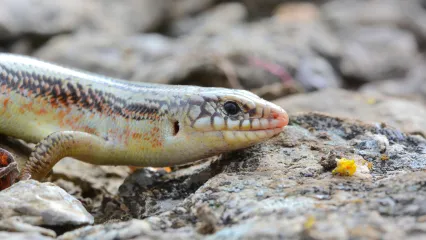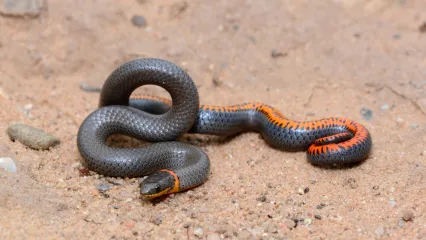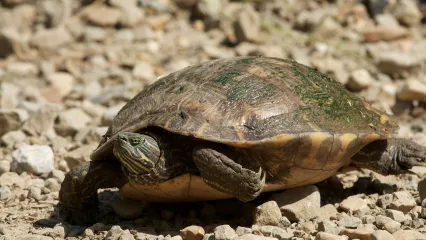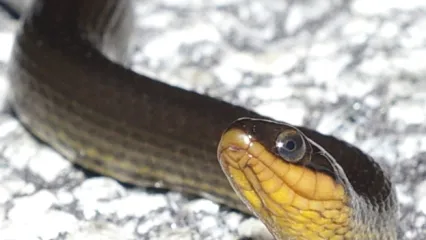
Description
The Great Plains skink can be distinguished from all other lizards in the region by a combination of large, smooth overlapping scales (glass-like), near equal fore-and hindlimb size, and scales on the lateral body surfaces arranged in diagonal rows. In addition, most, and sometimes nearly all scales on the body and tail are light-colored (tan or brown) with black to dark brown borders. Poorly defined stripes on the dorsal or mid-dorsal surface are sometimes present. Males have slightly larger heads than females of the same size and, during the breeding season, tend to have some orange coloration dispersed about the head, neck and body. Juveniles are colored completely differently from adults. The body and limbs are black, the tail is an iridescent blue, light areas on the head are orange, and scales along the upper jaw are white.
Size
These are relatively large skinks, with adults reaching just over 5 ½ inches in snout to vent length. The tail, if it has not been lost and regenerated, is about 10 percent longer than the lizard.
Habitat
The North American distribution of Great Plains skinks extends from central Arizona in the west to far western Missouri and north-south from southern Nebraska into northern Mexico. Although they are often associated with rocky outcrops and canyons, they can also be found in open areas like grasslands or prairies.
Life Cycle
Great Plains skinks are active from mid-March through early October. Mating occurs from late April through May and probably into June. Females deposit clutches varying in size from 7-17 eggs during June and July, and clutch size is associated with female size. Individual females may not breed every year and it is likely that resource availability (food) determines whether or not they breed. Females deposit eggs in shallow burrows that they excavate under rocks. Once eggs are deposited, females remain with the eggs until they hatch. Most likely, brooding of eggs in a small space aids egg development as the result of water provided to the eggs from respiratory water loss by the brooding female. This occurs in other skinks that have been studied. Egg attendance may also provide some protection from some nest predators, such as long-nosed snakes. Eggs hatch in late July through early September, and hatchlings are about 1.4 in snout to vent length when they emerge from eggs. No parental care occurs after hatching. Based on growth studies conducted in Kansas on Great Plains skinks, sexual maturity is reached in the third year of life. Great Plains skinks eat a variety of insects, but beetles, grasshoppers, crickets, and spiders comprise most of the diet.
How To Observe
These are extremely shy and elusive lizards and are difficult to observe easily. They can be found under flat rocks in April and May. Because they forage on the ground during late morning and late afternoon, they can be seen by remaining still while carefully surveying areas with a combination of rocks and shrubs.
(This profile was created by Dr. Laurie Vitt as part of a partnership between the Wildlife Department and the Sam Noble Oklahoma Museum of Natural History. It was funded as part of a larger State Wildlife Grant to survey and inventory amphibians and reptiles of the Wildlife Management Areas of Oklahoma: T-35-P-1.)


